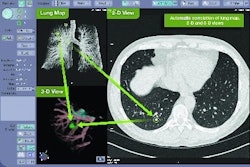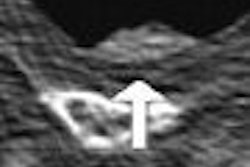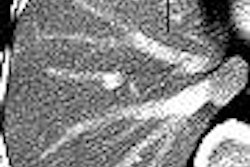MRI is the best technique to assess early tibial stress injury, but CT is the method of choice for detecting osteopenia, an early sign of fatigue damage of the cortical bone, according to a recent study by Italian researchers.
Exercise-induced stress reactions and stress fractures involving the tibia may account for up to 75% of exertional leg pain and stress fractures, the researchers from the departments of radiological sciences and sport medicine at the University of Messina in Messina, Italy, wrote in their study published in Radiology (May 2005, Vol. 235:2, pp. 553-561). Early detection may prevent complications of stress fracture and lead to faster recovery, they noted.
The prospective study compared the effectiveness of bone scintigraphy, CT, and MRI in 42 patients involved in exercise such as running, basketball, soccer, and handball, and who had clinically suspected tibial stress injuries. Both tibiae were evaluated in eight of the patients.
Ten asymptomatic volunteers involved in sports formed a control group and underwent CT and MRI. Scintigraphy was not performed because of ethical considerations.
MRI showed the highest sensitivity, depicting abnormalities in 44 tibiae, while scintigraphy depicted abnormalities in 37 and CT in 21. There was a statistically significant difference in the detection rate between MRI and CT (p < 0.001) and between MRI and scintigraphy (p = 0.008).
A statistically significant difference was also found between scintigraphy and CT (p = 0.02). Comparisons were done using the McNemar test for paired proportions. The standard of reference was a review of clinical findings, physical examination, and detailed history of three experienced sports medicine physicians.
Patients with other causes of chronic leg pain were not included in the study.
MRI, CT, and scintigraphy
Sensitivity, specificity, accuracy, and positive and negative predictive values were calculated for MRI and CT. For scintigraphy, only the sensitivity (74%) could be calculated. Conventional radiography showed no evidence of bone abnormality in any of the 42 patients. The patients had no history of trauma either.
|
MR, CT, and bone scintigraphy were done within one month of onset of lower leg pain, and the images were evaluated for fracture, cortical abnormalities, bone marrow edema, and periosteal edema. Cortical abnormalities were categorized as osteopenia, resorption cavity, or striation.
"Imaging findings correlate well with the spectrum of physiopathologic bone response to stress. We believe that osteopenia, resorption cavity, and striation occur as early lesions preceding the formation of cortical fracture," the researchers wrote.
MRI was done on a 1.5-tesla Magnetom Vision (Siemens Medical Solutions, Erlangen, Germany) with a phased-array coil. MRI pulse sequences consisted of transverse T1-weighted fast spin-echo sequences, transverse T2-weighted fast-spin echo sequences, and transverse fast STIR sequences. Coronal and sagittal images were obtained additionally to better define craniocaudal extension of the lesion in 14 patients.
For bone scintigraphy, patients underwent radionuclide bone scanning three to four hours after injection of 20 mCi (740 MBq) of technetium-99m methylene diphosphate. Imaging was done using the planar model on a dual-head gamma camera.
CT was performed using a Somatom Plus 4 scanner and Somatom Sensation 16 scanner (Siemens Medical Solutions) with 2-mm collimation, 15-mm table increment, 120 kVp, and 120 mAs.
MR and CT better than scintigraphy
CT identified the maximum number of cortical abnormalities, depicting them in 21 tibiae, as opposed to 17 on MRI and 13 on scintigraphy. Osteopenia was seen in the anterior cortex in 10 tibiae, posterior cortex in three, and both anterior and posterior cortices in eight. Resorption cavities were found in 13 tibiae and striations in 11.
For patients with negative CT scans, neither MRI nor scintigraphy could demonstrate cortical abnormalities. On MR, the cortical abnormalities were appreciable on T2-weighted images and fast STIR images. They were of lesser value in T1-weighted images.
MR imaging better detected bone marrow edema and periosteal edema, identifying bone marrow edema in 20 tibiae, compared with two in CT, and periosteal edema in 12, compared with only one in CT. MR also detected two fractures that were not visible on CT.
Fractures were visible in all MR imaging sequences. However, T1-weighted imaging could not demonstrate periosteal edema except in one case. Bone marrow edema was visible on T1- and T2-weighted images but demonstrated with more confidence on fast STIR images.
Based on these findings, "MR imaging should be considered the technique of choice in assessment of early tibial stress injuries; however, CT is the method of choice in detection of osteopenia, which is the earliest sign of fatigue damage of the cortical bone," the researchers concluded. "Both CT and MR imaging provide early findings of stress injury in patients with activity-related tibial pain."
Imaging plays an essential role in identifying abnormalities, although evaluating patients with potential tibial stress injury initially relies on clinical suspicion, they added.
By N. Shivapriya
AuntMinnie.com contributing writer
July 20, 2005
Related Reading
MDCT, scintigraphy yield very different reads on wrist fractures, May 18, 2005
Soccer players' injury rates tracked in British study, April 22, 2005
Study finds MRI is overused in sports medicine, February 24, 2005
Increased RA pain may be due to stress fracture, December 27, 2004
MR keeps stress fractures from becoming career wreckers, December 9, 2004
Copyright © 2005 AuntMinnie.com



















